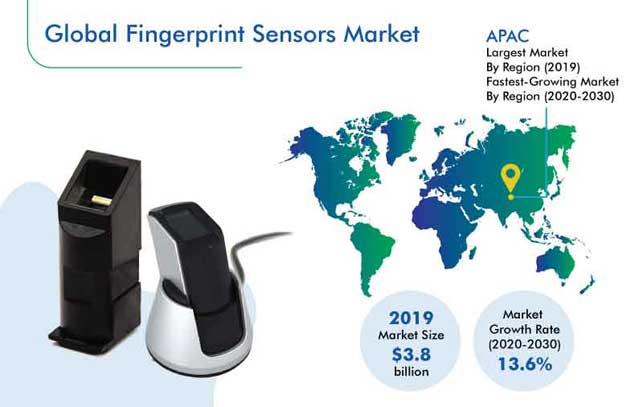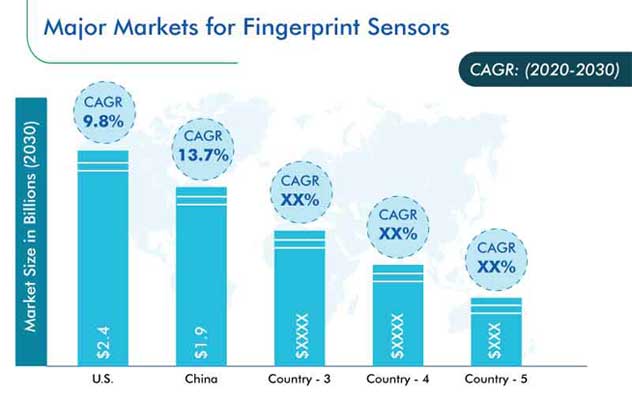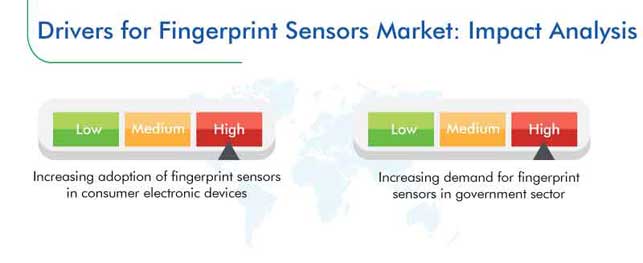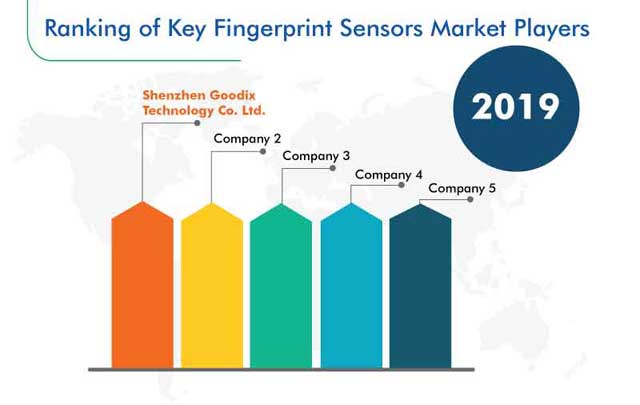Report Code: 12024 | Available Format: PDF | Pages: 139
Fingerprint Sensors Market Research Report: By Type (Area/Touch Sensors, Swipe Sensors), Technology (Capacitive, Optical, Thermal, Ultrasonic), Vertical (Consumer Electronics, Government, BFSI, Commercial Offices/Buildings, Hospitality and Healthcare)-Global Industry Analysis and Growth Forecast to 2030
- Report Code: 12024
- Available Format: PDF
- Pages: 139
- Report Description
- Table of Contents
- Market Segmentation
- Request Free Sample
Fingerprint Sensors Market To Generate More Revenue from Area/Touch Sensors
From $3.8 billion in 2019, the global fingerprint sensors market value is expected to advance at a CAGR of 13.6% during 2020–2030. The key reason behind the increasing sale of such instruments is the rising demand for them in the government sector and consumer electronics. Such devices like biometric sensors generate a digital image of the fingerprint pattern, which is why they are important in areas where the authentication of people’s identity is required.

Segmentation Analysis of Fingerprint Sensors Market
Area/touch sensors, under segmentation by type, would generate higher revenue in the market till 2030. This is attributed to their better sensing ability than swipe sensors, which is why they are widely adopted in consumer electronic devices, such as laptops and smartphones.
Historically, the capacitive category, on the basis of technology, dominated the market, as such these sensors are more cost-effective than those using other technologies. Moreover, capacitive technology in biometric sensors are easier to use, and they also provide better security to the data of the user.
The banking, financial services, and insurance (BFSI) division, based on vertical, is predicted to observe the highest market CAGR in the coming years. This would be because of the swift introduction of biometric sensors by banks around the world and rising focus on ways to prevent cybercrimes, which have plagued the industry for quite some time now.
Currently, the largest procurer of fingerprint sensors is Asia-Pacific (APAC), as a result of the growing demand for such instruments by the Indonesian, Chinese, and Indian governments, for official verification purposes. In addition, with the increasing disposable income of the continuously booming population, the popularity of smartphones is rising in the region, thereby propelling the integration of such sensors.

In-Display Fingerprint Sensors Are Trending in Market
The most prominent trend being seen in the fingerprint sensors market is the adoption of in-display variants. This has been a result of the increasing use of online payments and uptake of smartphones around the globe. Further, with the strong focus of smartphone manufacturers on decreasing the bezels and making the devices sleeker and smoother, they are rapidly integrating in-display fingerprint sensors. For instance, the X series of smartphones with in-display sensors was launched by Vivo Communication Technology Co. Ltd. in 2018. In the same vein, Qualcomm Incorporated introduced an ultrasonic in-display fingerprint sensors, which is more secure and reliable than its previously launched line of optical sensors, in 2019.
Rising Requirement for Fingerprint Sensors by Governments Is Driving Market
Among the most important factors driving the fingerprint sensors market is the rising demand for such instruments from the government of various countries. Military headquarters, government organizations, courts, and other such public bodies are quickly installing advancedsensors, with a focus on making the premises more secure. These instruments are also being adopted to authenticate the identity and prevent duplication, during the provision of various services to the public. For instance, the Unique Identification Authority of India (UIDAI) uses Aadhaar-based biometric identification to disperse the benefits sanctioned under various social welfare schemes to the economically weaker sections. Under the Aadhaar model, the fingerprints of people are captured, so their identity can be authenticated while distributing the benefits.

Advent of Biometric Cards in BFSI Sector Is Attractive Market Opportunity
An attractive opportunity area for the fingerprint sensors market is the emergence of biometric cards in the BFSI domain. The risk of thefts and frauds in the sector is rising, with the growing penetration of the internet and connected devices, which is creating a demand for these sensors to mitigate such threats. Compared to a conventional payment card, one which is equipped with the fingerprint-reading technology is more secure as well as faster. Payment cards integrated with such sensorsnot only authenticate the users’ identity in less than one second, but they also offer more security than a standard four-digit pin. In 2018, Visa Inc., in collaboration with Bank of Cyprus and Mountain America Credit Union, launched its dual-interface biometric payment cards on a pilot basis.
| Report Attribute | Details |
Historical Years |
2014-2019 |
Forecast Years |
2020-2030 |
Market Size by Segments |
Type, Technology, Vertical |
Market Size of Geographies |
U.S., Canada, Germany, France, U.K., Italy, Russia, Japan, China, India, South Korea, Brazil, Mexico, Turkey, South Africa, U.A.E., Egypt |
Explore more about this report - Request free sample
Product Launches Are Leading Companies to Prosperity
To gain a wider customer base across varied industries, companies in the fingerprint sensors market are quickly launching new products.
For instance, in February 2020, Fingerprint Cards AB added capacitive touch sensors, under the FPC1024 and FPC1020 series, to its portfolio of fingerprint authentication touch sensors, which the company supplies to logical and physical-access device manufacturers. With a smaller size than its previous variants, these sensors are designed for better biometric performance.
In the same vein, the Dannoline of low-power light-emitting sensors (LES)-based fingerprint scannerswere launched by Integrated Biometric LLC in June 2019. With low power requirement, low weight, and compactness, these instruments have been purposely designed for biometric fingerprint identification applications.

The key players in the global fingerprint sensors market are Synaptics Incorporated, Fingerprint Cards AB, Egis Technology Inc., Apple Inc., Qualcomm Incorporated, Integrated Biometrics LLC, Shenzhen Goodix Technology Co. Ltd., id3 Technologies, Next Biometrics Group ASA, and IDEX Biometrics ASA.
Fingerprint Sensors Market Size Breakdown by Segment
The fingerprint sensors market report offers comprehensive market segmentation analysis along with market estimation for the period 2014–2030.
Based on Type
- Area/Touch Sensors
- Swipe Sensors
Based on Technology
- Capacitive
- Optical
- Thermal
- Ultrasonic
Based on Vertical
- Consumer Electronics
- Smartphone
- Wearable device
- Laptop/notebook/personal computer (PC)
- Government,
- Banking, Financial Services, and Insurance (BFSI)
- Commercial Offices/Buildings
- Hospitality and Healthcare
Geographical Analysis
- North America
- U.S.
- Canada
- Europe
- Germany
- France
- U.K.
- Italy
- Russia
- Asia-Pacific
- Japan
- China
- India
- South Korea
- Latin America
- Brazil
- Mexico
- Middle East and Africa
- Turkey
- South Africa
- U.A.E.
- Egypt
The fingerprint sensors market is growing because of the increasing usage of such instruments in consumer electronics and the government sector.
The ultrasonic category, based on technology, will witness the highest CAGR in the fingerprint sensors industry.
The fingerprint sensors market has the brightest future in APAC.
The fingerprint sensors industry has been segmented on the basis of type, technology, vertical, and region.
Product launch is the key growth strategy of fingerprint sensors market players.
Want a report tailored exactly to your business strategy?
Request CustomizationWant an insight-rich discussion with the report author?
Speak to AnalystOur dedication to providing the most-accurate market information has earned us verification by Dun & Bradstreet (D&B). We strive for quality checking of the highest level to enable data-driven decision making for you
Our insights into the minutest levels of the markets, including the latest trends and competitive landscape, give you all the answers you need to take your business to new heights
With 24/7 research support, we ensure that the wheels of your business never stop turning. Don’t let time stand in your way. Get all your queries answered with a simple phone call or email, as and when required
We take a cautious approach to protecting your personal and confidential information. Trust is the strongest bond that connects us and our clients, and trust we build by complying with all international and domestic data protection and privacy laws